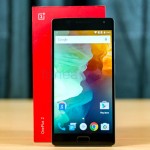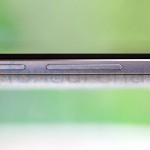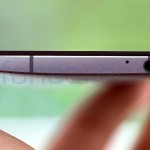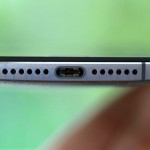OnePlus is quickly turning out to be a household name. It just took OnePlus about 12 months to become a hero from a zero. The company’s marketing strategy with all the social media hype and of course, the invite system made sure that the demand was always soaring through the roof.

With their first device, OnePlus set out on a mission – to offer great performance, while still keeping the price tag very affordable. It sounded similar to Google’s Nexus program, but as turns out OnePlus managed to beat the Nexus pricing hands down. It’s still quite hard to figure out how the company is doing that.
OnePlus who claims to Never Settle has entered its second year of operation and the company has a new device to take over the flagship duty. The Chinese manufacturer calls it two (OnePlus 2) and again their goal is simple – offer the best smartphone experience at an ultra-affordable price. Does the OnePlus 2 manage to do that? Well, let’s find out in our detailed review.
Unboxing
The OnePlus team has redesigned the packaging for its newest smartphone. The 2’s packaging looks simple and comes with OnePlus color scheme of red and white hue.
OnePlus 2 retail box consists of a 2-pin A/C adapter, USB Type-C cable, some leaflets and of course the device itself in Sandstone Black rear. We had already unboxed the OnePlus 2 and in case you missed it earlier, you can check out the video below.
One of the novel features of the OnePlus 2 is its USB Type-C port. The new interface also means that it required a new cable. So, the cable from the company now comes with a USB Type-C connector at one end, and USB Type-A plug at the other end. The best part of the OnePlus’ cable is that it is reversible at both the ends.
Design
Just like its predecessor, the design of the OnePlus 2 is also very subtle. It doesn’t have any flashy accents – it’s just clean and simple. The device looks very elegant from the front. The newly added physical home button, which also doubles up as a fingerprint scanner wastes no time in grabbing attention.
The OnePlus 2 has an aluminium frame running around the sides of the device. The structure has some plastic antenna strips that allow the antennas to do their radio magic. These strips make a nice accent over the brushed aluminium finish.
While the OnePlus 2 looks like a unibody smartphone, the users can still remove the back cover. You get the Sandstone back panel, which has a sand paper like texture, out of the box. But, there’s a wide range of optional rear covers like Kevlar, Bamboo, Rosewood or Black Apricot to you could pick to match your style statement.
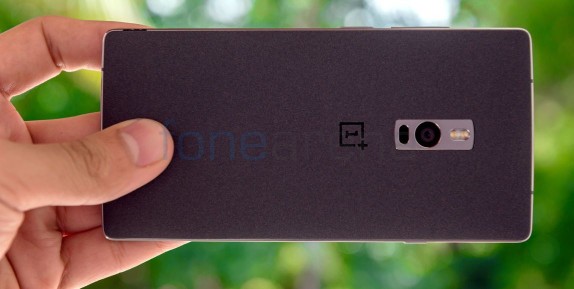
The camera kit has been relocated and the OnePlus logo has been etched under it. OnePlus 2 comes with the home backed Oxygen OS out of the box, so there’s no Cyanogen branding on the rear panel.
The edges on the 2 are rounded and the sides are flat. The overall shape is quite reminiscent of the OnePlus One. The back has a gentle curve that contributes to the comfortable feel in the palm. The buttons on the smartphone are thin and sharp.
OnePlus 2 measures 151.8 x 74.9 x 9.9mm – it is slightly taller than the Samsung Galaxy Note 4 that has 0.2-inch bigger display and about 2.9mm taller than LG G4. It weighs about 175 grams, which is as much as Galaxy Note 4, but a lot heavier than G4. The weight of the OnePlus 2 is definitely felt, but that also contributes towards the solid feel in the hand.
The front of the OnePlus 2 is dominated by a huge 5.5-inch display. Above the touchscreen, you can find the earpiece in the centre, a 5 megapixel front facing camera, proximity and ambient light sensors. Under the display, there’s a home button and two capacitive keys that serve as multitasking and back button. You can also use on-screen buttons if you favour them.
OnePlus has included a fingerprint scanner and it sits right below the physical key on the front. The scanner is very accurate and it is extremely handy to able to unlock the phone using the fingerprint when the device is in sleep / screen-off state.
On the right side, the OnePlus 2 has a volume rocker and at around thumb-height, the device has the power button. On the left, there’s a switch, which the company calls it as ‘Alert Slider’. As the name suggests, the button essentially allows you to toggle between different kinds of notification alerts. It’s a three way switch with options like none, priority and all. You get a subtle vibration acknowledging the choice of notification alert.

The 3.5mm audio jack along with the noise-cancelling microphone pinhole is found on top of the device. At the bottom, we have the USB Type-C port in the centre and on either side of it are the speaker grilles.
Moving to the rear, the camera kit grabs our attention. The 13 megapixel camera lens is in the middle, while a dual-LED flash and laser autofocus module are placed on top and bottom of the camera sensor respectively. There’s a plate covering the entire camera kit, which actually makes the lens less vulnerable to sniffs and scratches.
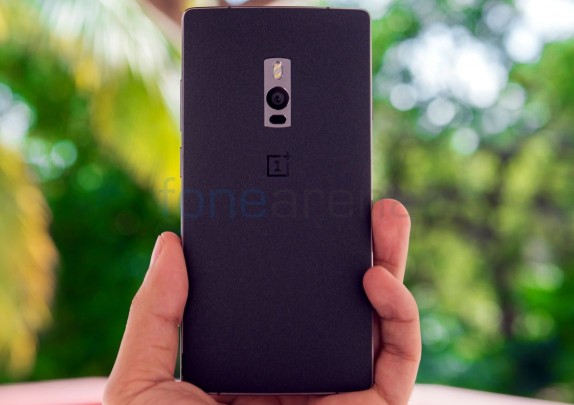
As mentioned before, the back panel of the OnePlus 2 is removable and underneath it sits the dual-nano SIM card slots. The battery is non-removable.
OnePlus has done pretty much everything it can do to make sure that the handling of the device is comfortable. But, you better have big hands, because anything beyond 5-inch makes a smartphone just too big and there’s no getting around that.
Display
The OnePlus 2 sports a 5.5” display with a resolution of 1080 x 1920 pixels and accounts to a pixel density of 401ppi. Technically, the viewing panel hasn’t been changed from the OnePlus 2’s predecessor, but the company has worked towards improving the overall performance of the screen.
The display on the OnePlus 2 is brighter and has more accurate color reproduction than the screen found on the One. While most of you might have preferred a QHD display, we think 1080p is just fine and it’s good to see that OnePlus is not keen on inflating specification sheets.
OnePlus 2’s IPS unit offers wider viewing angles and the good news is that the display has a layer of Corning Gorilla Glass 4 to protect the panel from minor sniffs and scratches. There’s also a oleo phobic coating for the display. OnePlus has also improved the screen-to-body ratio of the 2 by 1.4%.
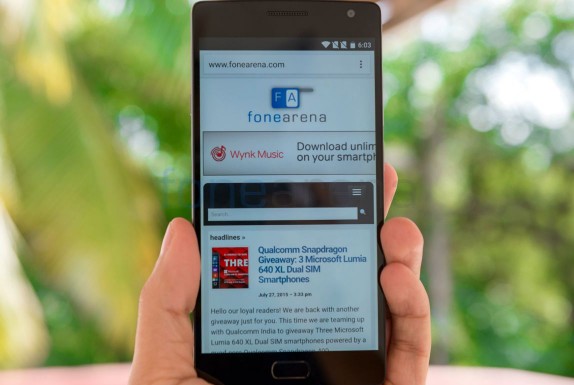
The brightness of the display when turned all the way up, outputs more than 600 nits, which is quite bright. The only concern was the contrast ratio as the blacks aren’t very deep neither at 50% brightness nor at its maximum.
As mentioned earlier, the front of the smartphone now features a fingerprint sensor. Just like the one on the HTC One M9+, the sensor on the OnePlus 2 is not a physical button, but however, you can use it as a capacitive home button. There are multi-tasking buttons in black hue on either side of the sensor. When switched to on-screen navigation, the functionality of the keys stop working.
Lastly, the sunlight legibility of the display is good, but it’s far from being the best in the class. We are happy to report that the reflectivity of the glass on top of the display is not too much and is something that won’t bother you.
User Interface
OnePlus built its own custom layer on top of Android Open Source Project a couple of months ago and the company named it Oxygen OS. OnePlus’s mobile operating system is as close to stock Android as you can get.
If you happen to be using the first generation device from OnePlus, then your experience with the new flagship will be vanilla. Oxygen OS doesn’t allow as much customization as Cyanogen did, but we are happy to report that we didn’t come across any major bugs with the new version and the platform is very stable.
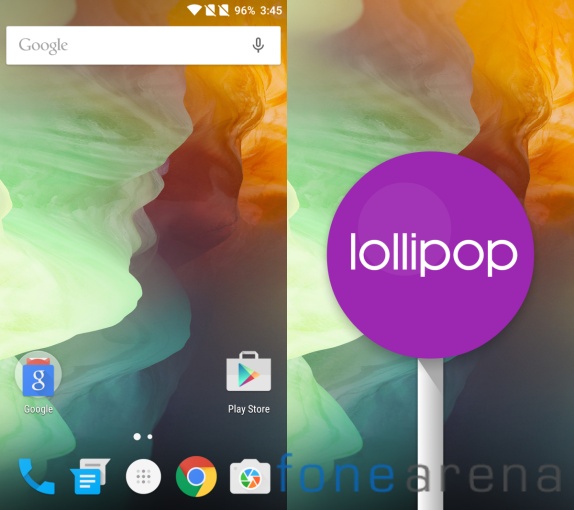
Oxygen OS 2.0 brings all the Google applications on board and we are glad that the Chinese manufacturer hasn’t included any bloatware. OnePlus’s home backed OS does support gestures and they work pretty well. Before we start discovering individual applications, we wanted to mention one cool feature that comes on board Oxygen OS – double tap to wake. It’s a simple option, but adds a lot of value.
While most of the Chinese firm built custom ROMs do not have an app drawer, Oxygen OS does have one. Since the OS is built on Android 5.0 Lollipop, all latest features from Android are on board. One of them is the new notification panel, which now allows you to access sub settings without having to move to a different screen.
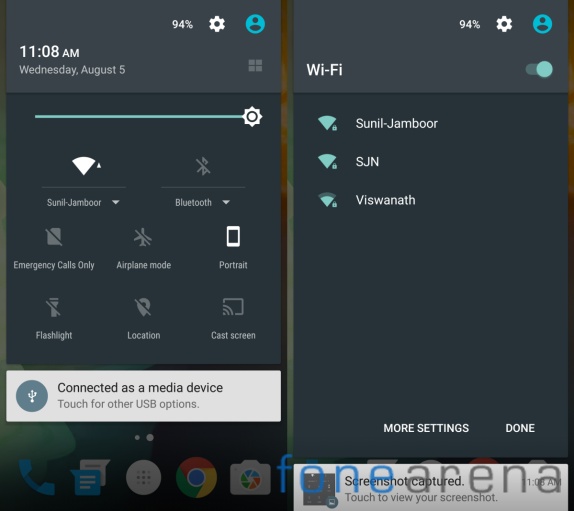
OnePlus 2 comes with a fingerprint sensor and brings a dedicated settings option for obvious reasons. Adding a fingerprint is very simple and all you need to do is just place your finger on the sensor a couple of times and bingo, your finger impression is registered. At this point in time, you can add about 5 fingerprints.
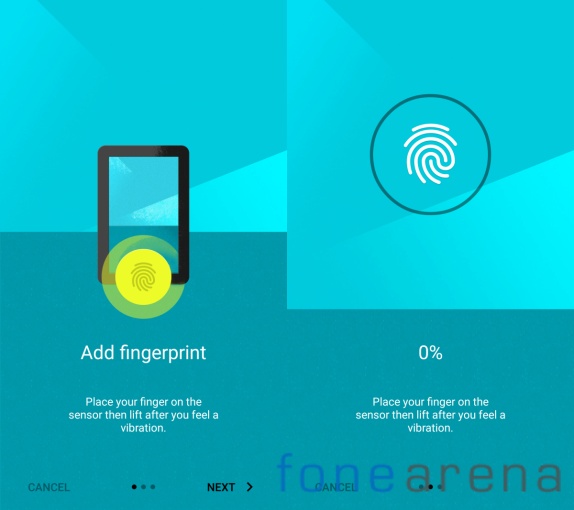
Oxygen OS also has a file manager using which you can access the internal storage of the device. You create folders, browse through them and copy or move files without any hassle. The app is really handy considering that you can store more than 50 gigs of data.
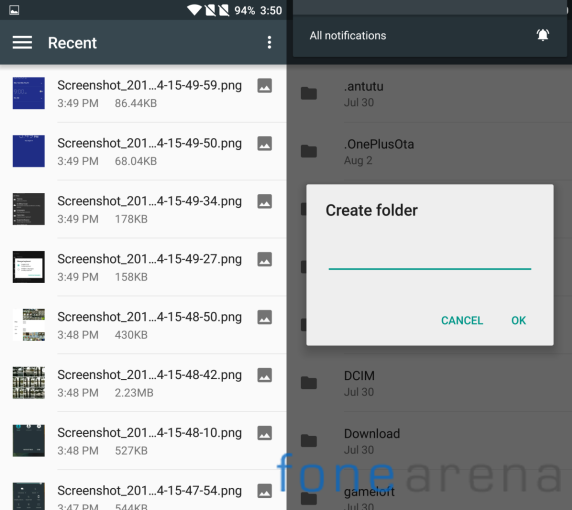
Google docs, slides and sheets come pre-installed on OnePlus 2 and these applications help you get stuff done on the go. None of these apps need an introduction, right?
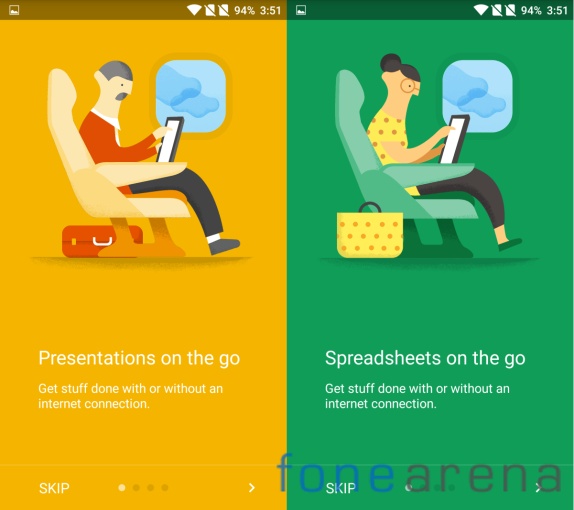
If you are very particular about sound, then you would love what Oxygen OS has got to offer – an Audio Tuner app, which gives you complete freedom with treble, bass and other options.
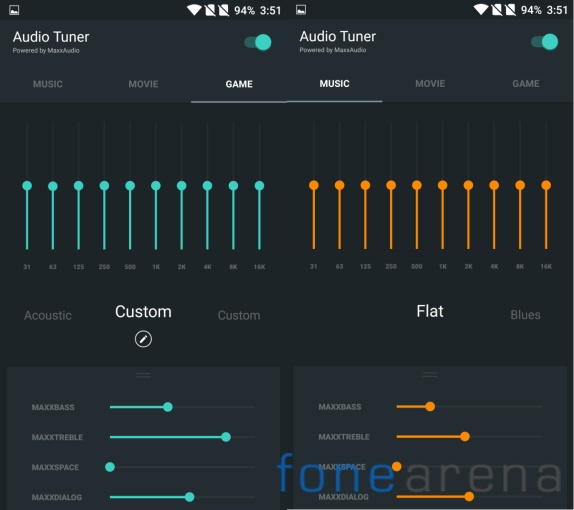
The Oxygen OS doesn’t have a dedicated gallery app, but you do get Google Photo as the default photo browsing app. We are not a big fan of Google Photo’s UI and the experience it offers is the not the greatest.
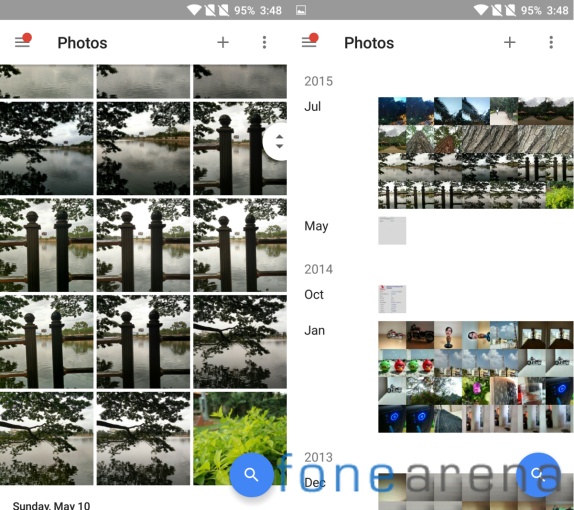
Performance
OnePlus 2 boasts one of the best hardware configuration available out there in the market. The device runs on Qualcomm’s top-class Snapdragon 810 chipset that comprises of four Cortex-A57 cores clocked at 2.0GHz and another four Cortex-A53 cores running at 1.5GHz. All the eight cores have 64-bit support, which is used to its full potential by the new ART runtime compiler within Android Lollipop.
The Snapdragon 810 also has a new Adreno 430 GPU that delivers better performance as compared to the Adreno 420 which was found on Snapdragon 805. Since the OnePlus 2 comes with a 1080p display, we expect the chip to provide blazing fast experience as compared to any QHD-screen flagship.
OnePlus 2 has 4GB of DDR4 RAM for the 64GB model and 3GB DDR4 RAM within the 16GB base variant. It’s quite hard to understand this separation and this is something that we don’t agree, but there’s nothing that we can do about it.
When LG G Flex 2 was announced, which apparently was the first smartphone on Snapdragon 810 chip, news broke that the silicon has some issues with overheating. The chip powering the OnePlus 2 is said to be the newer version of the 810.
Our impression is that OnePlus 2 does get warm after using the smartphone for a while, but the situation is not out of control. In fact, we appreciate what OnePlus has done in keeping the temperature as low as possible.
Before we put the device through our customary benchmarking tests, do check our gaming review below.
httpv://www.youtube.com/watch?v=QTmzdVWE3Js
We noticed one thing in our gaming review – OnePlus 2 does not utilize all the eight cores even while playing some of the most intense graphic games. However, the performance remained top notch.
We ran some popular benchmarking tests on the device to stack it up against its competition. And, if you are not aware about mobile device benchmarking, then we suggest you to check one of our featured stories to know more about it.
The OnePlus 2 entered the battle ring with the AnTuTu test that gauges the overall performance of the device. With a score of 52,929 OnePlus 2 is one of the high scoring devices available in the market.
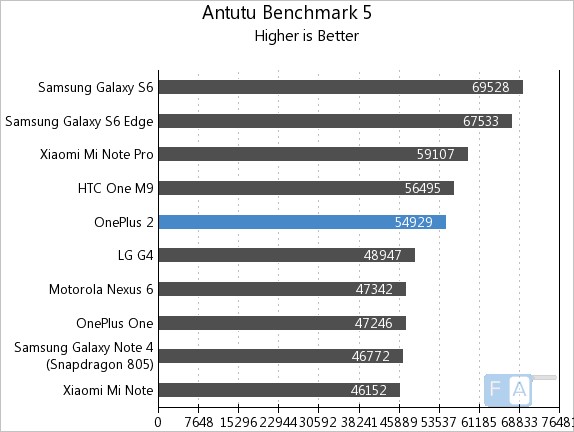
Next up was the Linkpack test, which measures the multi-threaded benchmarking of the OnePlus 2. The smartphone again finds itself among the best-selling flagship devices.
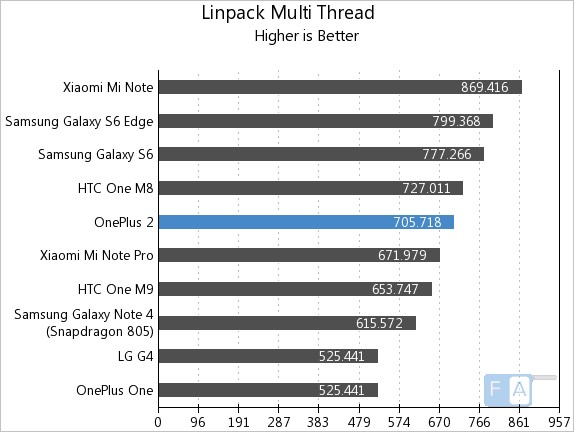
We then had the OnePlus 2’s Graphics Processing Unit sweating it out. The GFX benchmarking test reveals that the smartphone is one of the best in its class.
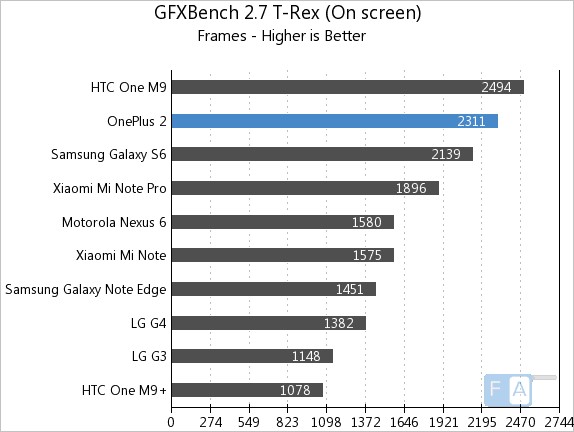
Lastly, we use the Vellamo application to test the browsing performance of the OnePlus 2. Our comparison chart reveals that the performance of the Chrome browser on the device is optimum.
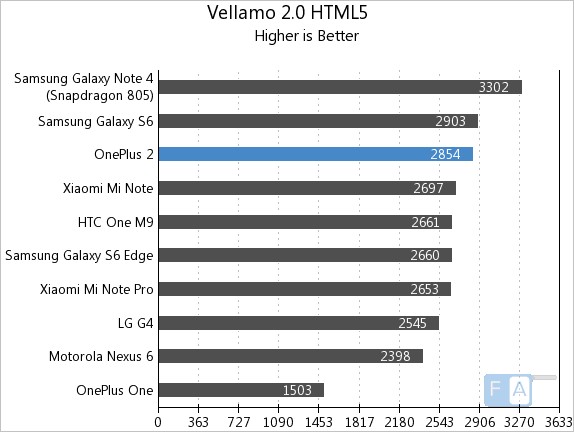
Overall, the performance offered by the OnePlus 2 is butter smooth. No matter what you throw, the Snapdragon 810 is capable of handling it. The 4GB RAM makes sure that you get one of the best multi-tasking experiences on a smartphone.
Camera
The OnePlus 2 comes with a 13 megapixel camera on the back coupled with a dual-LED flash and laser auto focus. On the front there’s a 5 megapixel snapper in charge of selfies. The camera hardware in terms of megapixels is same as the one found on the first gen OnePlus device. But, again the OnePlus team has managed to improve its performance and also add some new features.
OnePlus 2’s laser autofocus system locks focus in under 0.2 seconds. With some software help, the lasers automatically scan the scene and find a focus point. The camera also comes with optical image stabilization system which corrects shakes and also helps you capture some sharp pictures.
The camera interface on OnePlus 2 has a large virtual shutter button for stills, video and panorama. There are controls for switching the cameras, flash modes and shooting modes.
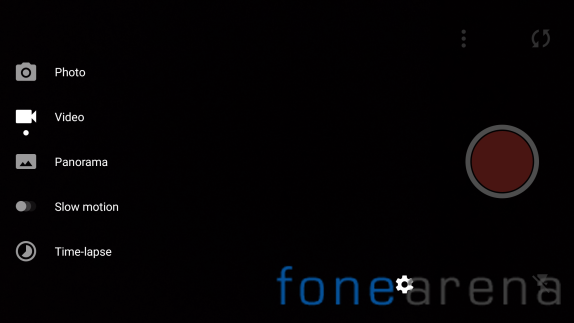
Snapping images is quick and easy on OnePlus 2. The device also stores them very quickly and within no time you are ready to the capture that next shot. But, the best thing about OnePlus 2’s camera is the quality of the images – it’s just amazing.
The white balance is spot on and the colors are slight saturated than in real life. The contrast is very impressive and the image looks sharp with very less softening in the corners. The dynamic range is good, but at times the OnePlus 2 leaves the shadows underexposed, while the highlights have sufficient exposure.

(Check out the full resolution samples)
The resolved detail is very high, but that comes at a cost – slightly noisier image than what we would expect. You wouldn’t even notice it if you are just moderate user, but we are just nit-picking here.
The HDR mode on the OnePlus 2 does a good job of opening up the underexposed areas of the image and improves the saturation. The Panorama mode offers low-resolution panoramas and the detail is only average. And, the image quality of 5 megapixel front facing camera will not blow you away, but it is definitely better than a lot of its competition. You can rely on to capture some shareable selfies.

Overall, all things considered, the OnePlus 2 captures very good images. The detail levels and the 13 megapixel resolution leave you with nothing much to ask for. We thoroughly enjoyed shooting images with the new OnePlus.
OnePlus manages to make the most out of Omnivision’s sensor and Qualcomm’s processor. The company offers you to record videos at 2160p@30fps as well as the DCI 2160p (4096 x 2160 pixels), which has a wider aspect and runs at 24 frames per second. Furthermore, you can also shoot videos at 1080p@30fps or slow motion video at either 1080p@60fps or 720p@120fps.
The clip that the OnePlus 2 manages to record is quite remarkable. The details are just incredible in good light conditions. The dynamic range again could have been better with shadow areas a bit exposed. Here’s a sample 2160p@30fps video. The bitrate is very high and the audio recorded is in stereo with high bitrate and sampling rate.
The 720p videos at 120 frames per second get rendered to 30fps making it perfectly viewable on bigger screen. OnePlus 2 is surely one of the best video recording smartphones available in the market. The overall quality is quite amazing. The DCI capture mode again stands out with 24 fps and a higher resolution.
Connectivity
The OnePlus 2 offers a wide range of connectivity options out of the box. The notable exceptions are IR blaster and NFC. Most of us believe that NFC connectivity goes well with a fingerprint scanner, but clearly OnePlus thinks the other way. OnePlus’s argument is that most of their OnePlus One users weren’t using NFC, so they didn’t include it in 2. Fair enough?
OnePlus 2 is a globetrotter when it comes to offering network connectivity. The device supports quad-band GSM, penta-band HSPA and hexa-band LTE. OnePlus 2 comes with a/b/g/n/ac Wi-Fi standards on both 2.4GHz and 5GHz bands. We did a 4G LTE speed test to show the performance to you all. Check it out below.
The OnePlus 2 has Wi-Fi Direct, hotspot, DLNA sharing, Bluetooth 4.1, microUSB v2.0 with on-the-go support and Type-C reversible connector.
Battery
The battery life on the OnePlus One was great, so our expectations for the 2 were very high. With a 3,300mAh battery, OnePlus 2 does offer you a day’s usage without any hassle.
We gave the device our own battery test treatment and the results were as expected. The device managed about 30 hours of call time, about 4 hours of 3G browsing, 5 hours of Wi-Fi browsing and close to 8 hours of video playback. It achieved an One Charge Rating of 11 hours and 24 minutes. Check out the complete set of battery test results here.
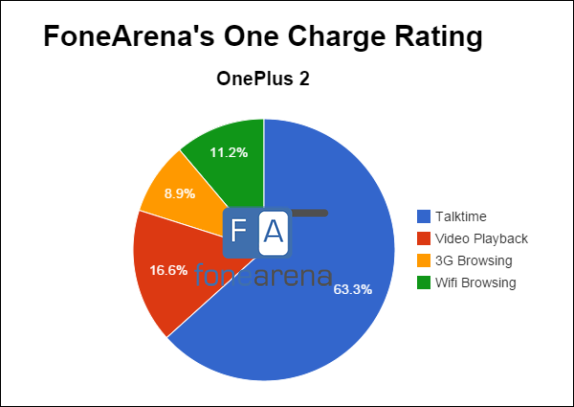
OnePlus 2 lacks quick charging feature, which means that refilling the battery is quite time consuming. There are two reasons that we can think of on why OnePlus hasn’t included quick charging – one, to save the licensing fee and keep the cost of the device low and two, the feature might have affected OnePlus 2’s thermal management very badly. Whatever the reason might be, quick charging is definitely missed.
Conclusion
OnePlus 2 with 64GB of internal memory is priced at INR 24,999 in India and $389 globally. To put it in one sentence, OnePlus 2 is a great device with a great price tag. Getting hold of one will be a challenge though. Bummer!
The OnePlus 2 has all the goods and the hardware you get at the price – Snapdragon 810, 4GB RAM, 13 MP camera, fingerprint sensor and 64GB memory is quite unbelievable.
The display is good and quite bright. The device is a champ when it comes to benchmarks, and the camera is something that you can easily fall in the love with. The video recording capability of the OnePlus 2 is as good as it can get.
We are quite happy with the overall thermal management as well. The short comings are the lack of IR blaster, NFC and quick charging, but that’s something we could live with.
If you are an Android purist, you will love the near stock Android experience and the UI is buttery smooth. There are some minor bugs, but we are sure that OnePlus will fix them with upcoming software patches and upgrades. The speakers on the OnePlus 2 are among the loudest and the battery life is quite solid.
Basically, OnePlus has got most of the things right with its latest flagship, the 2. OnePlus 2 is a package which is very difficult to resist. Near stock Android experience with super premium specifications at that price tag is like dream come true.

